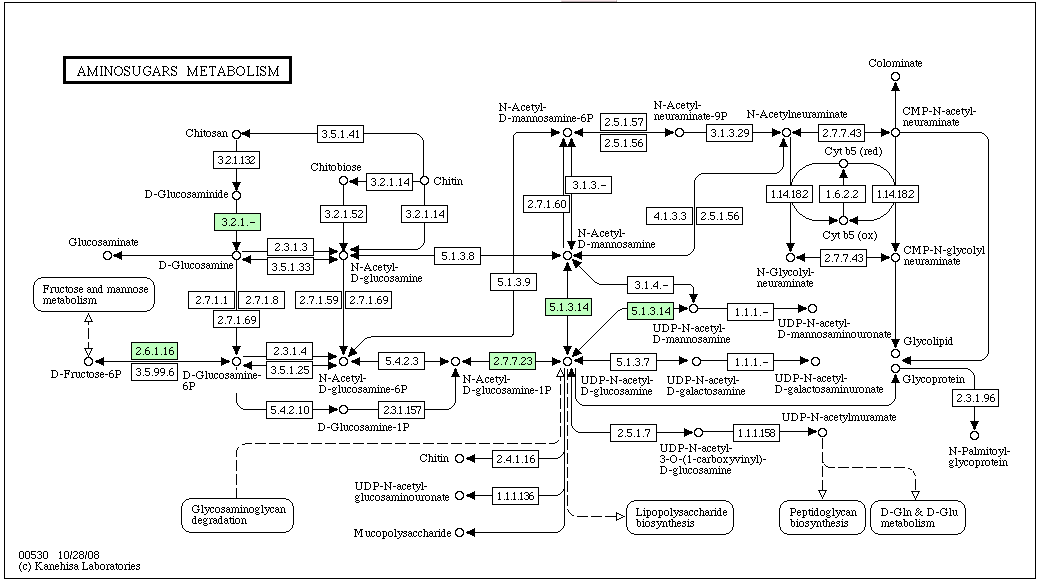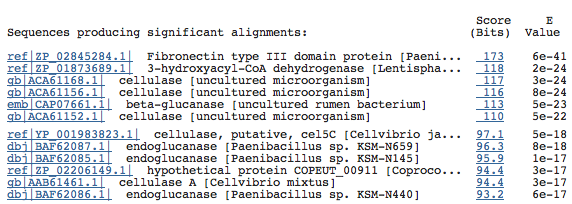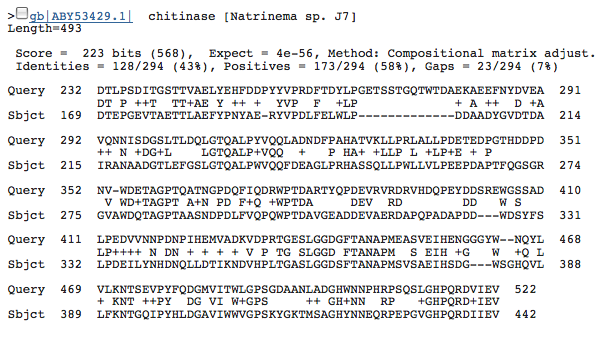Difference between revisions of "Chitinase"
| Line 1: | Line 1: | ||
KEGG Pathway containing Chitinase: Aminosugars Metabolism | KEGG Pathway containing Chitinase: Aminosugars Metabolism | ||
[[Image:pathway.png]]<br> | [[Image:pathway.png]]<br> | ||
| − | The pathway above is labeled for a halophile, haloarcula marismortui (most of the other halophiles on KEGG did not have a reference pathway for Aminosugars Metabolism). As you can see, | + | The pathway above is labeled for a halophile, haloarcula marismortui (most of the other halophiles on KEGG did not have a reference pathway for Aminosugars Metabolism). As you can see, chitinase (EC#:3.2.1.14) is not predicted for this halophile.<br> |
<br><br> | <br><br> | ||
| − | The only automated annotation database to predict a | + | The only automated annotation database to predict a chitinase was Manatee. Manatee predicted Chitinase A at 55855...57810. [http://www.tigr.org/tigr-scripts/prok_manatee/shared/ORF_infopage.cgi?db=nthu01&orf=ORF00052 Chitinase A: Manatee]<br> |
The top BlastP results: [[Image:blastpr.png]]<br><br> | The top BlastP results: [[Image:blastpr.png]]<br><br> | ||
As you can see, Chitinase A is not among the top hits. However, there is one hit for it further down the list:<br> | As you can see, Chitinase A is not among the top hits. However, there is one hit for it further down the list:<br> | ||
| Line 9: | Line 9: | ||
So, although it is possible that Chitinase is coded for by this region, there is a stronger possibility that it is not.<br> | So, although it is possible that Chitinase is coded for by this region, there is a stronger possibility that it is not.<br> | ||
<br><br> | <br><br> | ||
| − | While doing some hand-curated annotations, we also found another potential | + | While doing some hand-curated annotations, we also found another potential chitinase-coding region at 72986...74821 (+). Two hits were found by Blastp that coded for chitinase, they were the 2nd and 3rd hits overall and both were from halophiles: <br> |
First Chitinase hit: [[Image:ChitinaseBlast.png]] <br> <br> | First Chitinase hit: [[Image:ChitinaseBlast.png]] <br> <br> | ||
| − | Second Chitinase hit: [[Image:ChitinaseBlast2.png]] <br> | + | Second Chitinase hit: [[Image:ChitinaseBlast2.png]] <br> <br> |
| + | |||
| + | So, data from this coding region strongly suggest the coding of chitinase in our organism. However, we do not yet have any physiological data to support the presence of chitinase. | ||
Revision as of 16:10, 18 November 2008
KEGG Pathway containing Chitinase: Aminosugars Metabolism

The pathway above is labeled for a halophile, haloarcula marismortui (most of the other halophiles on KEGG did not have a reference pathway for Aminosugars Metabolism). As you can see, chitinase (EC#:3.2.1.14) is not predicted for this halophile.
The only automated annotation database to predict a chitinase was Manatee. Manatee predicted Chitinase A at 55855...57810. Chitinase A: Manatee
The top BlastP results: 
As you can see, Chitinase A is not among the top hits. However, there is one hit for it further down the list:
![]()
So, although it is possible that Chitinase is coded for by this region, there is a stronger possibility that it is not.
While doing some hand-curated annotations, we also found another potential chitinase-coding region at 72986...74821 (+). Two hits were found by Blastp that coded for chitinase, they were the 2nd and 3rd hits overall and both were from halophiles:
First Chitinase hit: 
Second Chitinase hit: 
So, data from this coding region strongly suggest the coding of chitinase in our organism. However, we do not yet have any physiological data to support the presence of chitinase.